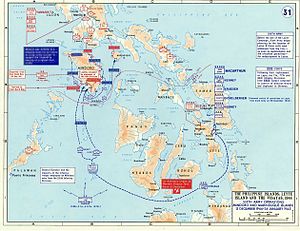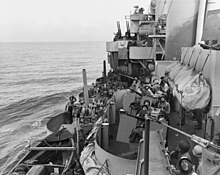Battle for Mindoro
| date | December 13, 1944 to December 16, 1944 |
|---|---|
| place | Mindoro , Philippines |
| output | American victory |
| Parties to the conflict | |
|---|---|
| Commander | |
| Troop strength | |
| about 10,000 soldiers, 2,000 seamen | about 1,200 soldiers |
| losses | |
|
18 dead, |
around 200 dead, |
Leyte - Operation Te and Operation Wa - Gulf of Leyte - Mindoro - Luzon - Manila - Palawan - Visayas - Mindanao
The Battle of Mindoro was a military operation under the Philippines Campaign during the Pacific War in World War II . The aim of the American operation was to take the Philippines island of Mindoro by means of an amphibious attack. The landings of the US armed forces began on December 13, 1944. After three days of fighting against the Japanese garrison, Mindoro was considered secure from December 16 . However, isolated Japanese groups fought until August 1945, when the Japanese Empire finally surrendered .
prehistory
Mindoro and the surrounding islands were captured and occupied by the Imperial Japanese Army right at the beginning of the Japanese operations in the Pacific region in 1942 (→ Battle of the Philippines ). Smaller garrisons were posted on the islands; Mindoro was mainly used for its airfields. When the Joint Chiefs of Staff had the first plans to recapture the Philippines drawn up under the code name Musketeer in 1943 , the main focus was on the two larger islands of Leyte and Luzon . Mindoro did not move forward until September of the following year in plan revision number 3 ( Operation Musketeer No. III ) at the urging of General Douglas MacArthur , as the airfields on Mindoro, which were in Japanese hands, were strategically important for the landings on Luzon . The plan was to begin the landings on Mindoro immediately after taking Leyte . Operation Musketeer III planned to take the southwestern part of Mindoro from December 5, 1944: 10,000 marines and army soldiers were to quickly eliminate the small Japanese garrison in the south. The rest of the island was controlled by Filipino guerrillas who fought the Japanese troops on Mindoro since early 1942. After the airfields located on Mindoro were prepared for use, the landings on Luzon should then begin on December 20th. The plan was cleared for implementation by the Joint Chiefs of Staff on October 3, 1944. MacArthur then assembled a smaller fleet and approximately 10,000 army units from the 24th Infantry Division under the command of General Roscoe B. Woodruff .
The battle
Support operations

Task Force 38 under Vice Admiral John S. McCain was deployed to support the landings on Mindoro and later also on Luzon . It was divided into three groups ( Task Groups ): Task Group 38.1 under Rear Admiral Albert E. Montgomery with four aircraft carriers , two battleships , four cruisers and 18 destroyers , Task Group 38.2 under Rear Admiral Gerald F. Bogan with five aircraft carriers, three battleships, five Cruisers and 20 destroyers, as well as Task Group 38.3 under Rear Admiral Frederick C. Sherman with four aircraft carriers, three battleships, four cruisers and 18 destroyers. The fighter planes of this task force flew air raids against the Japanese-occupied airfields on Luzon and Mindoro between December 14 and 16, 1944 in preparation for the landings. Some planes and PBY Catalina flying boats flew over the island reconnaissance and photographed the enemy positions on the beaches.
On December 18, 1944, however, Task Force 38 was caught in the severe Typhoon Cobra . Three destroyers sank during the storm, killing 750 sailors. Four aircraft carriers, a cruiser and five destroyers were damaged, some severely, and the fleet had to accept the loss of 146 aircraft that were washed overboard. Almost all of the damaged ships had to return to Leyte to do makeshift repairs and then go to Pearl Harbor , Hawaii for final repairs .
The landing in the south
Although Japanese reconnaissance planes sighted the approaching American convoy in the Mindanao Sea on December 13, they mistakenly assumed a course for Negros or Panay . Although a severe kamikaze attack on the Nashville was carried out on December 13 during the call to Mindoro (133 dead, including many officers of the management staff), the convoy was otherwise unmolested. Japanese patrol planes searched the beaches of Negros and Panay the next day in vain, expecting to find American landing efforts there. It was only when the convoy anchored off San Jose on December 15, 1944 that the Japanese realized that the real destination was Mindoro.
The convoy was led by Task Group 78.3 under Rear Admiral Arthur Dewey Struble . The Western Visayas Task Force under Brigadier General Willam C. Dunckel ( flagship Nashville ) with the 503rd Parachute Regiment, 19th Infantry Regiment of the 24th Infantry Division was on the ships . Cover groups under Rear Admiral Russell Stanley Berkey and Rear Admiral Theodore Davis Ruddock stood ready for protection. Further kamikaze attacks took place during and after the landings, but the intended beaches could be occupied without a single man lost. By nightfall all supplies were brought ashore. San Jose was captured in the evening and work on the nearby airfields could begin. Mindoro was considered secure from December 16, although only the southern part had been occupied by then. The Japanese forces deployed on Mindoro had withdrawn inland and were preparing for a guerrilla fight there.
Operation REI
On December 24, a Japanese naval formation ran from Cam Ranh Bay to Mindoro and bombarded the American landing zone with the destroyer Kasumi under Rear Admiral Masatomi Kimura , a heavy and a light cruiser and five other destroyers. A transport ship was damaged by Japanese artillery and then by an American plane and had to be abandoned. When air strikes with B-25 bombers and fighters of the 5th US Air Fleet took place on the unit, and the destroyer Kiyoshimo was subsequently sunk by an American speedboat, the unit turned away and thus escaped destruction. The Japanese shelling caused only minor damage to the landing beaches.
An attack by the Baya submarine on December 27th under Lieutenant Benjamin Campbell Jarvis on the expiring unit was unsuccessful.
Train north
On January 1, 1945, the 8th US Army took control of Mindoro. MacArthur's further plan was for tactical conquests in the north of the island to cover the future landings on Luzon and possibly on Formosa . The first attempts were made on January 1st with Bongabong on the east coast of Mindoro and Calapan in the northeast of the island. On January 3, US forces captured Buenavista on the southwest coast of Marinduque , where they set up radar installations .
consequences
From the end of December 1944 to August 1945, the remaining Japanese on Mindoro fought fierce guerrilla warfare against the Philippine army , which was experienced in guerrilla warfare. This led to very high losses on both sides.
After the end of the war
According to press reports, the Japanese soldier Fumio Nakahara was discovered on Mount Halcon in April 1980 . He has apparently survived there in a small hut since the fighting ended. This information turned out to be incorrect: a search party discovered the hut in which some older weapons were also kept (including an Arisaka Type 99 rifle and hand grenades ); no trace of the Japanese soldier was found.
Individual evidence
- ^ The Campaigns of MacArthur in the Pacific, Chapter IX, The Mindoro and Luzon Operations .
- ^ The Campaigns of MacArthur in the Pacific, Chapter IX, The Mindoro and Luzon Operations, 250 .
- ↑ Jürgen Rohwer , Gerhard Hümmelchen : December 1944, Chronicle of the Naval War 1939–1945, Württembergische Landesbibliothek Stuttgart 2007.
- ↑ Japanese Holdouts: Registry .


